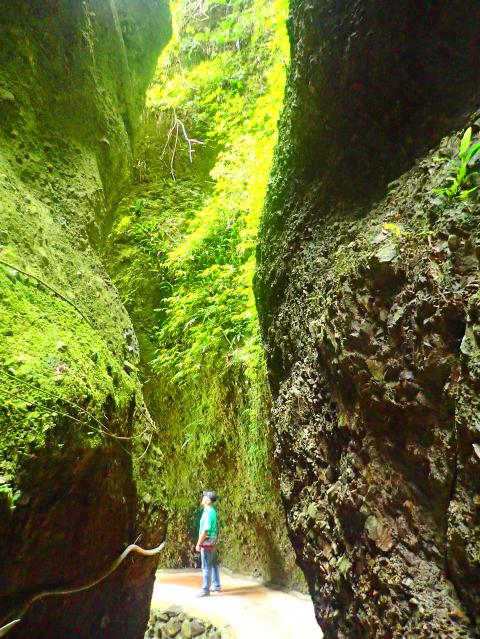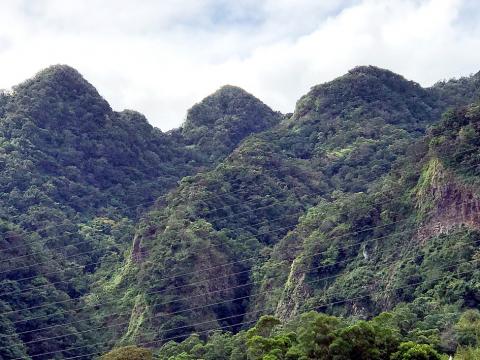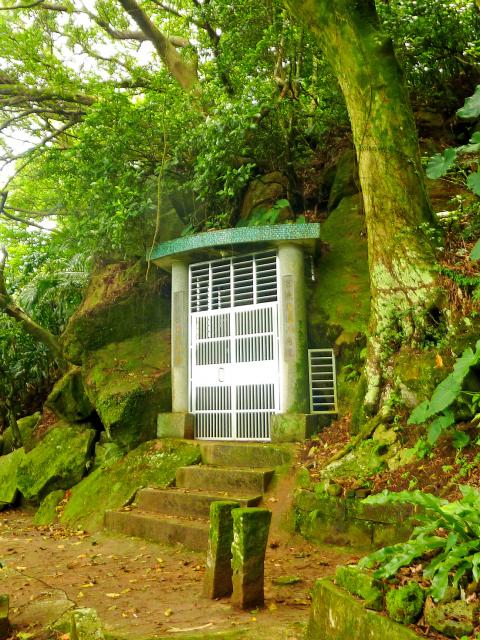New Taipei City’s Bali District (八里, across the river from Tamsui) isn’t a place that immediately springs to mind for tourist attractions. Its main draw, Formosa Fun Coast (八仙海岸), remains closed following a tragic fire, and today it’s probably best known for the huge new port development nearby.
The district is dominated by the many-peaked bulk of Guanyinshan (觀音山), an outlier of the Datun Mountain range. Early plans for what eventually became Yangmingshan National Park (陽明山國家公園) included this magnificent patch of rugged mountain scenery. Unfortunately, these came to naught, and the lower degree of protection afforded it as part of the North Coast and Guanyinshan National Scenic Area has left loopholes that have seen its lower slopes defiled by high-rise buildings. Despite the eyesores, it’s well worth exploring some of the less popular hiking routes on its slopes.
Back to Bali. Apart from Guanyinshan, Shisanhang Museum of Archaeology (十三行博物館) and the Bali Left Bank (八里左岸) tourist area, there’s not so much to attract visitors to the area, except for cyclists. Despite this, in a valiant attempt to increase the town’s tourist profile, some bright spark came up with the idea of creating an “eight sights of Bali” (八里八景), perhaps in imitation of the former Eight Sights of Taiwan (台灣八景), which have been promoted since the Qing Dynasty.

Photo: Richard Saunders
Being a confirmed nature lover, I’d personally throw out the undeniably impressive but manmade places on the list (Guandu Bridge, Port of Taipei and Bali Left Bank by night) and replace them with a couple of overlooked natural curiosities. So here is my personal choice of the best-of-the-eight (mostly natural) sights of Bali.
Start by crossing the Tamsui estuary by the impressive red-arched structure of Guandu Bridge (關渡大橋). On the west bank of the river, turn north along route 15 towards Bali, and in 800 meters, turn left beside a large open car park into Longxing 3rd Street (龍形三街), which soon climbs onto the shoulder of Guanyinshan. Follow the small hand-painted signs and if you don’t get lost you’ll end up at a small parking area just below Chaoyin Cave (潮音洞).
Chaoyin Cave is actually a narrow, dark cleft, whose walls close in on either side, almost blocking out the sky. The curious name is probably taken from the similarly crack-like cleft of the same name on Shanghai’s island of Putuo Mountain (普陀山) in China, the place where Guanyin is said to have achieved enlightenment. During an earlier visit, a local pointed out the carved rock which stands outside the entrance to the little canyon. Apparently, photos taken of it have revealed a ghostly pyramid when developed. Sad to say I had no success with any of my several attempts: maybe it only works for film cameras.

Photo: Richard Saunders
Chaoyin Cave is inexplicably left off the “official” list of Eight Sights, but to find Shibi Waterfall (石壁垂簾), which is on the list, return to route 15. Turn left towards Bali, and in 300 meters turn left again into Longxing 5th Street (龍形五街). Soon climbing into the folds of Guanyinshan's many ridges, this road offers some of the finest roadside views on the mountain. When you reach a boulder engraved with the characters for Sanqing Temple (三青宮), about 1.7 kilometers, turn left. At the fork, walk around a red iron gate on the left and follow the surfaced but overgrown lane ahead down to Shibi Waterfall. The 20m high waterfall pours into a secretive little gorge, and is generally only a trickle except after heavy rain.
Perhaps Bali’s most compelling natural curiosity is Quhu Immortals Cave (堀湖仙洞), the area’s only true cavern, and by several accounts one of the deepest known caves in Taiwan. It’s just above the settlement of Quhu (堀湖) on provincial route 50. In the village take a steep, narrow lane uphill signposted “neighborhood 8” (八鄰), and in a minute or two a gated concrete trail and steps on the right lead up past a seemingly uninhabited residence on the hillside above to the cave mouth. The entrance is now covered by an aluminum door which is locked for safety reasons. The entrance to the main part of the cave is reached by clambering up into a passage about three feet above the floor of the first chamber.
It’s intriguing to guess just how deep the cave is: no one seems to know. A local resident we got talking to claimed he once tried to explore it, taking a long rope (at least the first stage of the cave is a vertical shaft) and finally gave up when he came to the end of the rope.
.jpg)
Photo: Richard Saunders
In Quhu village a narrow road starting at Xilung Temple (西龍岩) descends the lower slopes of Guanyinshan's northern side, connecting with a lane near the bottom that leads to Dapenkeng archeological excavation area (大坌坑遺址). To the average person the area is just a wasteland of untidy scrub and stunted woodland, but several information plaques give a hint of the importance of this place, as the site of one of Taiwan’s earliest known human settlements.
IF YOU GO
Most of the places described are tucked away down the maze of narrow roads that crisscross the lower slopes of Guanyinshan, so make Google Maps your friend and use it to find the way. Cars can be driven up all the roads mentioned, but this is excellent scooter riding countryside, and is the preferred method of transport when exploring the area’s narrow roads.

Photo: Richard Saunders
Richard Saunders is a classical pianist and writer who has lived in Taiwan since 1993. He’s the founder of a local hiking group, Taipei Hikers, and is the author of six books about Taiwan, including Taiwan 101 and Taipei Escapes. Visit his Web site at www.taiwanoffthebeatentrack.com.

This is the year that the demographic crisis will begin to impact people’s lives. This will create pressures on treatment and hiring of foreigners. Regardless of whatever technological breakthroughs happen, the real value will come from digesting and productively applying existing technologies in new and creative ways. INTRODUCING BASIC SERVICES BREAKDOWNS At some point soon, we will begin to witness a breakdown in basic services. Initially, it will be limited and sporadic, but the frequency and newsworthiness of the incidents will only continue to accelerate dramatically in the coming years. Here in central Taiwan, many basic services are severely understaffed, and

Jan. 5 to Jan. 11 Of the more than 3,000km of sugar railway that once criss-crossed central and southern Taiwan, just 16.1km remain in operation today. By the time Dafydd Fell began photographing the network in earnest in 1994, it was already well past its heyday. The system had been significantly cut back, leaving behind abandoned stations, rusting rolling stock and crumbling facilities. This reduction continued during the five years of his documentation, adding urgency to his task. As passenger services had already ceased by then, Fell had to wait for the sugarcane harvest season each year, which typically ran from

It is a soulful folk song, filled with feeling and history: A love-stricken young man tells God about his hopes and dreams of happiness. Generations of Uighurs, the Turkic ethnic minority in China’s Xinjiang region, have played it at parties and weddings. But today, if they download it, play it or share it online, they risk ending up in prison. Besh pede, a popular Uighur folk ballad, is among dozens of Uighur-language songs that have been deemed “problematic” by Xinjiang authorities, according to a recording of a meeting held by police and other local officials in the historic city of Kashgar in

The People’s Republic of China (PRC) was out in force in the Taiwan Strait this week, threatening Taiwan with live-fire exercises, aircraft incursions and tedious claims to ownership. The reaction to the PRC’s blockade and decapitation strike exercises offer numerous lessons, if only we are willing to be taught. Reading the commentary on PRC behavior is like reading Bible interpretation across a range of Christian denominations: the text is recast to mean what the interpreter wants it to mean. Many PRC believers contended that the drills, obviously scheduled in advance, were aimed at the recent arms offer to Taiwan by the